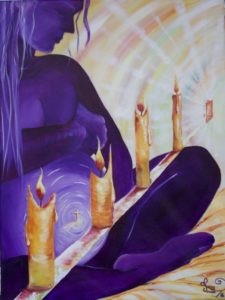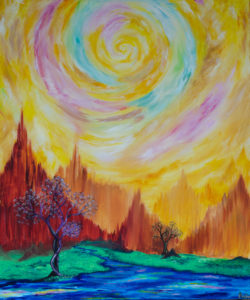These Painting we created in front of a live audience. This was done at either a conference or during a church service.
Released (Bellow) Was painted during a woman’s conference.
Titled: Released
Medium: Acrylic
Artist: Janine Aberg
Price: $700
Description: A girl jumping and butterfly coming out of its cocoon. The butterfly is a symbol of the girls experience. The girl is vulnerably released from her incubation into a new life experience. Like the butterfly, she has been completely ‘unmade’ in order to rise again.

This painting is made of three pieces. It was completed over a 3 day conference in Harrisonburg 2016.
Advent 2016
His World
Gemeinschaft:
Title: The Network of Our Identity
Medium: Acrylic on Canvas
Dimensions: 3 panels: 30” X 67”; 40” X 67”; 30” X 67” totals 100” X 67”
Year Created: 2015 – 2017
Story: This painting was conceived in the minds of a small group of men working together with Janine Aberg, during a 6 month period at Gemeinschaft Home, Harrisonburg. Noteworthy is that the painting was completed by a number of individuals. It is a work of community even more than a work of art, thus the style in some parts of the painting is more accomplished than in others. This is because the artist was working together with some men who had never painted before.
Led by Janine the group was discussing the idea of identity. The focus of which was on how our identities are a weaving together of the many aspects of life, as well as different stories and events, making up past, present, and future realities. Furthermore the painting contains the idea that individuals are not defined by any singular event in their lives, nor are individuals isolated from others in the formation of their identity. Individuals are a complex web of personality, relationships, decision making, spirituality, life events, history, and many other elements.
Every one of the men who participated in the project, shared the experience of having been in prison. However neither their stay behind bars nor their journey to get there, was the only defining part of their lives, it was only one of the many aspects of who they have become. Far too often these men, and woman in similar circumstances, are judged by the society we live in.
As you can see there are a number of different aspects of life represented in the painting. Beginning with the image in the lower far right, there is a depiction of hands resting on prison bars. These hands are not of an individual from any particular race, age, or group, but they are capable, men’s hands, trapped behind bars, which symbolize the shared experience of the men in the group. Other pictures in the network of identity that we chose to depict are, going right to left, a writer or an artist (notice he is penning the word “freedom”), then a man with a daughter or niece (they are symbolically torn apart on two different canvases), a portrait of a man showing care and humanity in his eyes. Then there is someone partaking in a sport’s activity (basket ball), and a man leaning over a spade, representing work, a man reading a spiritual book, a man being kissed by the woman he loves, and friendship (represented by a fist bump of men across cultures, in this case African American and Latino).
Looking deeper into the stories of the actual men who participated in the project and who are portrayed on the painting, there are a few more valuable insights. The man on the top right corner of the painting (which he painted much of himself) got out of prison, and did his 3 months at Gemeinschaft. Unfortunately he passed away, after suffering a heart attack, before the project was completed, which is a reminder of the brevity of life. The man who’s portrait is central in the painting is from South America. He had spent a number of years in prison and then made it to Gemeinschaft. As he prepared to leave however he struggled with getting his social security and other legal documents together in his second language (English). That combined with other stresses lead to him to make a number of bad decisions within the Gemeinschaft context, and he was sent back to jail. The young man in the image leaning on a spade, the man playing basketball on the lower portion of the painting, the man standing with his niece, and the man reading the holy book, all made it out of both prison and Gemeinschaft, and have restarted their lives with promising outcomes.
The painting has tried to represent most of the dominant races in the American prison system, Hispanic, Caucasian, and African American. The artist and the men woking on the project are well aware of the outnumbering statistics of people of color in the system, although this is unfortunately not overwhelmingly clear in the art work. We were working with participants in the group who offered to have their portraits in the painting and those in Gemeinschaft Home at that time.
The artist is deeply thankful for every person who spent hours painting, drawing lines, and carrying material back and forth between Gemeinschaft and the artist’s home. Much thanks to all who participated and supported this project, both at Gemeinschaft and those at Eastern Mennonite University.



